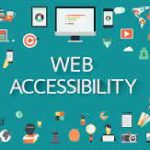Accessibility is a legal right and a moral imperative for business enterprises and social institutions today. It also makes business prudence, to invest in providing better accessibility. (Read our article on the increase in revenue of companies that invested in improving accessible here)
But, before gaining its legal stature & prominence, there has been a chequered history of community discrimination, unfair dismissal, and social oblivion of people with physical and mental disabilities. As a result, both in North America and Canada, the honorable judiciary and civil rights organizations had to step in to reinstate the rights of the disabled.
In this article, we will see how accessibility evolved in the United States and how businesses can use digital inclusiveness to leverage the future of the web.
The first initiative towards an inclusive world was made by American National Standard Institute (ANSI), an American non-profit organization in the United States. The organization laid the foundational work in accessibility by detailing the technical standards for buildings and facilities to be usable by disabled communities.
Peter Mills, a 12-year-old, African American was excluded from pursuing further studies at Brent Elementary School, Junior Village, Columbia. The fourth-grade student branded for having ‘Behavioral Problems’ was not readmitted at Brent Elementary public school. Mills was denied the right to education, for he could not find admission in any other public or private schools in Junior Village at the time.
Along with seven other minor children, who were faced with a similar situation, Mills sought justice and equal access to educational opportunities by filing a lawsuit against the State Educational Department at the District of Columbia court. The district court noted that all the minor children were denied access to publically funded education solely because of their ‘exceptional’ health status.
By Exceptional, the court cited various disabilities, including “mentally retarded, emotionally disturbed, physically handicapped, hyperactive and other children with behavioral problems.”
The landmark judgment by Judge Joseph Cornelius Waddy in December 1971 gave every child in the United States a legal right to pursue ‘free’ public education regardless of the severity of their physical or mental disability.
The 1971 case of Peter Mills vs. District of Columbia became a trendsetter for schools across the United States. It was also a precursor to the making of the Rehabilitation Act of 1973.
The first time a formal law to protect the right of citizens with disabilities came into force in 1973. Two rules came into force: Section 502 and Section 504.
Section 502 mandated accessibility standards for transport networks, roads, buildings, public spaces, and other public infrastructures built using federal funds.
Did you know?
Section 508 was declared in 1998 as an amendment of Section 502, Rehabilitation Act of 1973!
Section 504 prohibited discrimination of people with physical disabilities in any initiatives or programs sponsored using federal funds.
EAHCA or EHA, or Public Law (PL) 94-142, declared by United States Congress to all publically funded schools of the country, provided equal, indiscriminate access to education for ‘all’ children.
The law mandated public schools to establish special education services, dedicated program monitoring, educational accessibility compliance audits, and dispute resolution mechanisms for children with physical and mental disabilities.
In 1988, Federal Government provided grants to States to develop programs, procedures, and initiatives targeted to promote tech accessibility for disabled citizens. As a result, the United States governments, both at national and state levels, prioritized equitable access to Technology and Information Systems through the use of assistive devices and services through this initiative.
The most comprehensive civil rights law came into force to protect the rights, prohibit discrimination, and provide equitable opportunities for disabled citizens.
Until 1990, and the happening of the ADA law, legal rights for the disabled were largely propagated in public-funded federal projects. But, for the first time, ADA required all public and private institutions, businesses, and individuals to protect the rights of the disabled in all areas of public life, including employment, education, transport, and community places.
The law also mandated any employers with over 15 employees to provide employment and reasonable accommodation as outlined by the US Equal Employment Opportunity Commission report. Today, all business enterprises and social institutions must meet ADA accessibility standards for legal compliance.
President Clinton signed an amendment to the 1973 Rehabilitation Act to accommodate equitable access to electronic and information technology. The law mandated all federal agencies to use information and communications technology (ICT), including computer technology (software and hardware), online training materials, and Federal pages on the internet, accessible for disabled federal employees and the general public. However, the law, at the time, was applicable only for Federal ICT assets.
In 2017, ADA was amended to extend accessible ICT for private institutions. In addition, accessibility standards became applicable to business enterprises.
However, today Section 508 compliance applies to all Federal, Business, Educational and Social institutions.
In 2008, the ADA Amendments Act (ADAAA) termed and broadened the scope of the word ‘disability’ to include people with limiting impairments of all kinds. Thus, the word ‘disability’ meant all impairments that substantially limited an individual from performing one or more major life activities.
This law was a huge milestone in that those with half-impairments, like low vision, partial hearing, partial physical disabilities, and minor shades of mental disorders could benefit from ADA rights.
Communications and Video Accessibility Act (CVAA), signed by President Barack Obama, was enforced to increase accessibility features of modern communications. As a result, all modern communications, including text messaging, e-mail, instant messaging, and video communications, were required to incorporate closed captions, audio supplements, and other accessibility features to help disabled individuals. The CVAA also provided a ramp to mobile phone and web accessibility.
The US Access Board refreshed the Section 508 standards and the 255 guidelines to keep up with the new market trends and technological advancements. The rule also incorporated compliance to Web Content Accessibility Guidelines (WCAG) 2.0 guidelines for web content. Federal agencies’ rules mandated web content and digital assets to achieve either A or AA levels of WCAG 2.0. By complying with WCAG 2.0 guidelines, the law also aimed to harmonize with the international standards of web accessibility.
As an enhancement to the previous 2.0 standards, W3C released an updated version of recommendations and guidelines to achieve web accessibility standards.
As an enhancement to the previous 2.0 standards, W3C released an updated version of recommendations and guidelines to achieve web accessibility standards.
WCAG 2.1 is the most updated standard for web and mobile accessibility.
The focus of the new release was more towards making mobile content accessible for disabled users. WCAG 2.1 also provided additional markup, styles, and text recommendations for publishing text, image, audio, and video content on the web.
A closer look at the history of accessibility standards in the United States will reveal reforms, amendments, or updates were being made periodically almost for two to three years. In addition, the design standards of web accessibility are constantly shifting to keep up with the latest technological innovations, as well.
Therefore, business enterprises must understand why accessibility matters more in the future of the web.
Accessibility is much more than the markup standards, design features, or assistive mobile features provided for disabled communities on the web. Many accessibility features that were initially conceptualized for disabled individuals are today used by regular people, too.
For instance, the Google Auto-complete chrome feature: Initially released to assist partially disabled users, is now used by regular users.
The pwWebSpeak text-to-speech converters created by Productivity Works were also initially targeted to help blind people read the contents of the web. But, today, text-to-speech synthesizers are used in almost all technological applications, including Microsoft Windows, Android Apps, and Smart IoT devices.
Also, Apple SIRI, a DARPA-funded CALO project, first explored options for blind users to talk to computers and receive information back in audio formats. However, today, we all know how Apple Siri, and other competing products like Amazon Echo or Google Home, have evolved to serve all communities of the world and not just those in the disabled segments.
Microsoft HoloLens is another classic case: designed initially to help blind people navigate buildings, HoloLens is also trending to provide augmented reality experiences for regular users.
Almost all IoT smart devices, Machine Learning algorithms, and Artificial Intelligence innovations use a combination of text, audio, and video formats to provide personalized information or services for users.
The future of the web is backward compatible in terms of accessibility: the future tech, especially AI and IoT, will comply with the previous standards of web accessibility by default. However, that would mean an even greater need for business enterprises to incorporate accessibility standards of their existing digital assets.
The future will be about accessibility through Smart IoT, Machine Learning, and Artificial Intelligence innovations.
By making your existing digital assets accessible, your business enterprise will be future-ready!
codemantra assists organizations in transforming digital assets to meet the most updated standards of legal and web accessibility. We can help your business comply with evolving compliance laws and also be future-ready. E-mail us at info@codemantra.com to learn more.






